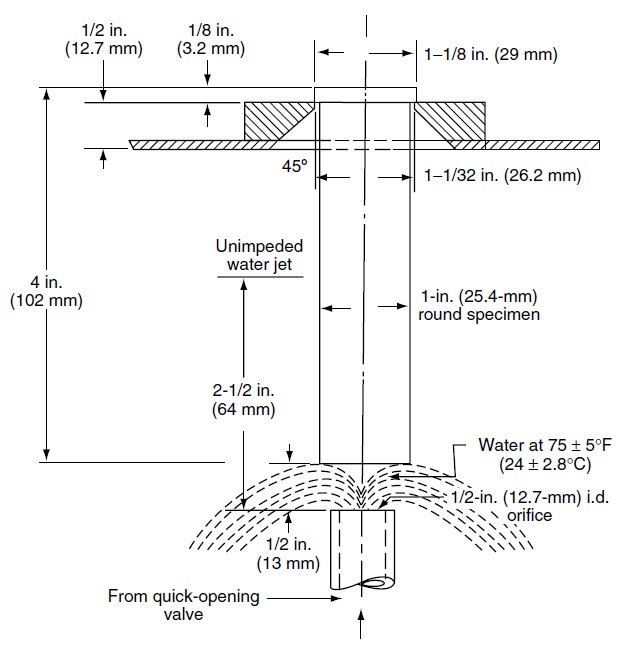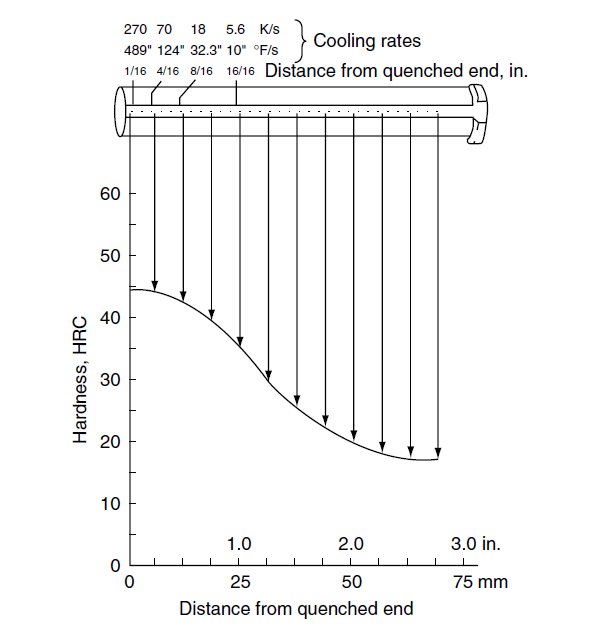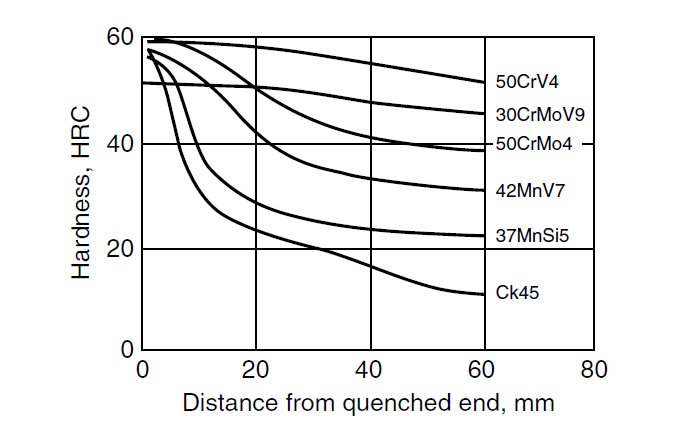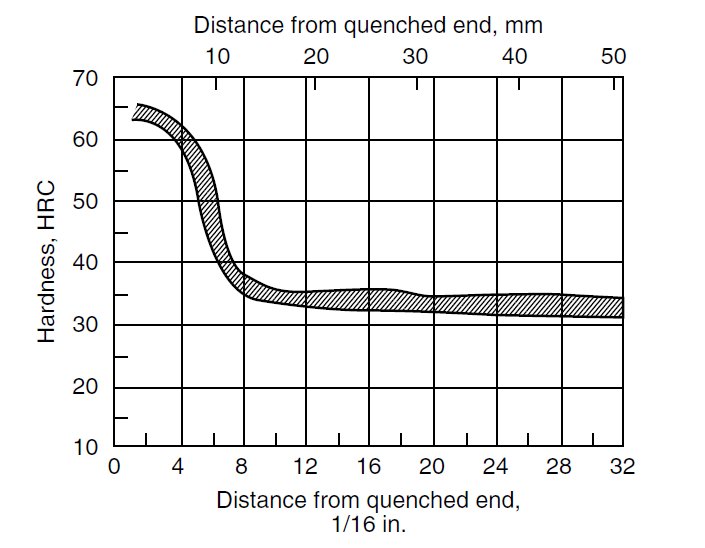
Alphabetical Index
Chemical Composition
Keyword Search
AFNOR Steels
AISI/SAE Steels
BS Steels
DIN Steels
EN Steels
JIS Steels
JUS Steels
GB Steels
GOST Steels
Mat.No (Wr.Nr.) Steels
Alloy Steels
Boron Steels
Carbon Steels
Case Hardening Steels
New Diagrams
Nitriding Steels
Spring Steels
Steel Companies
Structural Steels
Tool Steels
Help
Home
Jominy End-Quench Hardenability Test
The end-quench hardenability test developed by Jominy and Boegehold is commonly
referred to as the Jominy test. It is used worldwide, described in many national standards, and
available as an international standard. This test has the following significant advantages:
1. It characterizes the hardenability of a steel from a single specimen, allowing a wide range of cooling rates during a single test.
2. It is reasonably reproducible.
The steel test specimen (25 mm diameter x 100 mm) is heated to the appropriate austenitizing
temperature and soaked for 30 min. It is then quickly transferred to the supporting
fixture (Jominy apparatus) and quenched from the lower end by spraying with a jet of water
under specified conditions as illustrated in Figure 1. The cooling rate is the highest at the
end where the water jet impinges on the specimen and decreases from the quenched end,
producing a variety of microstructures and hardnesses as a function of distance from the
quenched end. After quenching, two parallel flats, approximately 0.45 mm below surface, are
ground on opposite sides of the specimen and hardness values (usually HRC) are measured at
1=16 in. intervals from the quenched end and plotted as the Jominy hardenability curve (see
Figure 2). When the distance is measured in millimeters, the hardness values are taken at
every 2 mm from the quenched end for at least a total distance of 20 or 40 mm, depending on
the steepness of the hardenability curve, and then every 10 mm. On the upper margin of the
Jominy hardenability diagram, approximate cooling rates at 700 C may be plotted at several
distances from the quenched end.
Jominy specimen and its quenching conditions

Figure 1: Jominy specimen and its quenching conditions for end-quench hardenability test.
Measuring hardness on the Jominy specimen

Figure 2: Measuring hardness on the Jominy specimen and plotting the Jominy hardenability
curve. (From G. Krauss, Steels Heat Treatment and Processing Principles, ASM International, Metals
Park, OH, 1990.)
Figure 3 shows Jominy hardenability curves for different unalloyed and low-alloyed
grades of steel. This figure illustrates the influence of carbon content on the ability to reach a
certain hardness level and the influence of alloying elements on the hardness distribution
expressed as hardness values along the length of the Jominy specimen. For example, DIN
Ck45, an unalloyed steel, has a carbon content of 0.45% C and exhibits a higher maximum
hardness (see the value at 0 distance from the quenched end) than DIN 30CrMoV9 steel, which has only 0.30% C. However, the latter steel is alloyed with Cr, Mo, and V and shows a
higher hardenability by exhibiting higher hardness values along the length of the specimen.
The Jominy end-quench test is used mostly for low-alloy steels for carburizing (core hardenability) and for structural steels, which are typically through-hardened in oils and
tempered. The Jominy end-quench test is suitable for all steels except those of very low or very
high hardenability, i.e., D1< 1.0 in. or D1> 6.0 in. The standard Jominy end-quench test
cannot be used for highly alloyed air-hardened steels. These steels harden not only by heat
extraction through the quenched end but also by heat extraction by the surrounding air. This
effect increases with increasing distance from the quenched end.
Jominy hardenability curves

Figure 3: Jominy hardenability curves (average values) for selected grades of steel (designations
according to German DIN standard). (From G. Spur (Ed.), Handbuch der Fertigungstechnik, Band 4-2,
Wa¨rmebehandeln, Carl Hanser, Munich, 1987, p. 1012.)
The reproducibility of the standard Jominy end-quench test was extensively investigated,
and deviations from the standard procedure were determined. Figure 4 shows the results of
an end-quench hardenability test performed by nine laboratories on a single heat of SAE 4068
steel. Generally, quite good reproducibility was achieved, although the maximum difference
may be 8–12 HRC up to a distance of 10 mm from the quenched end depending on the
slope of the curve. Several authors who have investigated the effect of deviations from the
standard test procedure have concluded that the most important factors to be closely
controlled are austenitization temperature and time, grinding of the flats of the test bar,
prevention of grinding burns, and accuracy of the measured distance from the quenched end.
Other variables such as water temperature, orifice diameter, free water-jet height, and transfer
time from the furnace to the quenching fixture are not as critical.
Reproductibility of the end-quench hardenability test

Figure 4: Reproductibility of the end-quench hardenability test. Hardenability range (hatched
area between curves) based on tests by nine laboratories on a single heat of SAE 4068 steel. (From
C.A. Siebert, D.V. Doane, and D.H. Breen, The Hardenability of Steels, ASM International, Cleveland,
OH, 1997.)
Reference: George E. Totten, Steel Heat Treatment: Metallurgy and Technologies, CRC Press, 2007, pp. 228-230.